Dialogue Examples for a Person Seeing There Father Again
Any writer worth their salt knows that dialogue is one of the most useful tools in their arsenal: it tin can provide exposition, develop your characters, and move your plot along. That's why we've put together a gear up of guidelines for how to write corking dialogue. Only sometimes information technology'due south easier to acquire past example. With that in mind and to help illustrate those rules, in this mail nosotros've got some dialogue examples to show yous them in action.
Nosotros'll be sharing 15 examples of dialogue from well-known authors, and breaking downward exactly why they piece of work so well.
1. Barbara Kingsolver, Unsheltered
In the opening of Barbara Kingsolver'due south Unsheltered, we meet Willa Knox, a middle-anile and newly unemployed writer who has only inherited a ramshackle firm.
"The simplest thing would be to tear it down," the man said. "The house is a abattoir."
She took this news as a blood-blitz to the ears: a roar of peasant ancestors with rocks in their fists, facing the evictor. Only this man was a contractor. Willa had chosen him here and she could transport him away. She waited out her panic while he stood looking at her butchery, appearing to nurse some satisfaction from his diagnosis. She picked out words.
"It's non a living affair. You lot can't merely pronounce it expressionless. Anything that goes wrong with a construction can be replaced with another structure. Am I right?"
"Correct. What I am maxim is that the structure needing to be replaced is all of information technology. I'm sorry. Your foundation is nonexistent."
Alfred Hitchcock once described drama as "life with the wearisome bits cut out." In this passage, Kingsolver cuts out the boring parts of Willa'southward conversation with her contractor and brings us right to the tensest, most interesting part of the conversation.
By entering their chat tardily, the reader is spared every tedious detail of their interaction.
Instead of a blow-by-blow account of their negotiations (what she needs done, when he's complimentary, how she'll be paying), we're dropped right into the emotional center of the discussion. The novel opens with the narrator learning that the home she cherishes can't be salvaged.
By starting off in the middle of (relatively obscure) dialogue, it takes a moment for the reader to orient themselves in the story and figure out who is speaking, and what they're speaking about. This disorientation most mirrors Willa'south own reaction to the bad news, as her expectations for a new life in her new home are swiftly undermined.
Costless course: Writing Keen Dialogue
Your journey to becoming a master of dialogue starts here. Go started now.
two. Jane Austen, Pride and Prejudice
In the beginning slice of dialogue in Pride and Prejudice, we meet Mr and Mrs Bennet, as Mrs Bennet attempts to depict her husband into a conversation about neighborhood gossip.
"My dear Mr. Bennet," said his lady to him 1 solar day, "take you heard that Netherfield Park is let at terminal?"
Mr. Bennet replied that he had non.
"But it is," returned she; "for Mrs. Long has just been here, and she told me all about it."
Mr. Bennet made no respond.
"Do you not want to know who has taken information technology?" cried his wife impatiently.
"Y'all want to tell me, and I have no objection to hearing it."
This was invitation enough.
"Why, my dearest, yous must know, Mrs. Long says that Netherfield is taken past a fellow of big fortune from the north of England; that he came down on Monday in a chaise and 4 to see the place, and was so much delighted with information technology, that he agreed with Mr. Morris immediately; that he is to accept possession before Michaelmas, and some of his servants are to be in the house past the terminate of next week."
Austen'due south dialogue is ever witty, subtle, and packed with grapheme. This extract from Pride and Prejudice is a groovy example of dialogue being used to develop character relationships.
We instantly learn everything we need to know almost the dynamic between Mr and Mrs Bennet's from their beginning interaction: she's chatty, and he'southward the beleaguered listener who has learned to entertain her idle gossip, if only for his own sake (hence "you want to tell me, and I have no objection to hearing it").
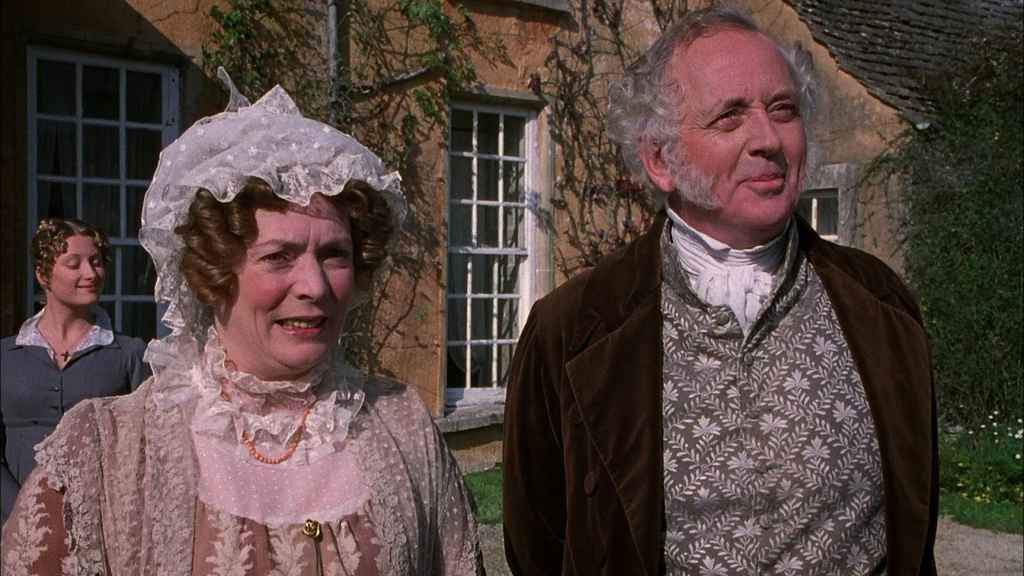
There is fifty-fifty a clear difference between the two characters visually on the folio: Mr Bennet responds in short sentences, in simple indirect spoken language, or non at all, just this is "invitation enough" for Mrs Bennet to launch into a rambling and extended response, dominating the conversation in text but as she does audibly.
The fact that Austen manages to imbue her dialogue with so much graphic symbol-building realism means we inappreciably find the corporeality of crucial plot exposition she has packed in here. This heavily expository dialogue could be a drag to get through, merely Austen'southward colorful characterization means she slips it under the radar with ease, forwarding both our understanding of these people and the globe they live in simultaneously.
iii. Naomi Alderman, The Power
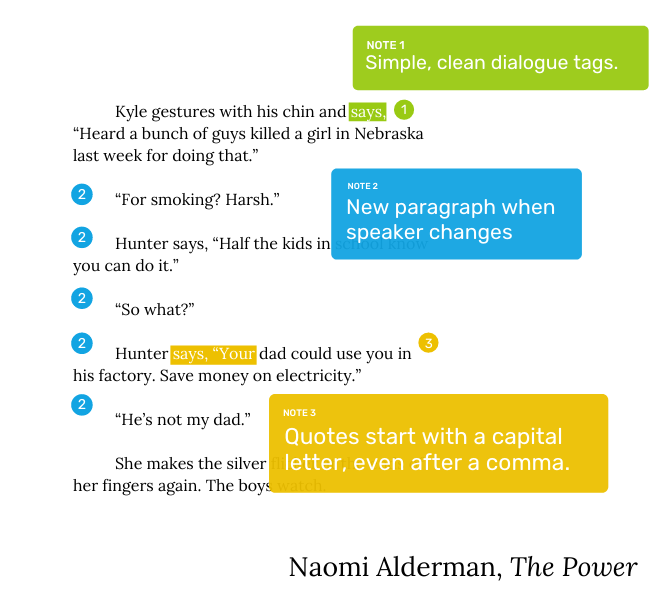
In The Ability, young women around the world suddenly find themselves capable of generating and controlling electricity. In this passage, between ii boys and a girl who just used those powers to light her cigarette.
Kyle gestures with his chin and says, "Heard a bunch of guys killed a girl in Nebraska last week for doing that."
"For smoking? Harsh."
Hunter says, "Half the kids in school know you can exercise it."
"So what?"
Hunter says, "Your dad could apply yous in his manufactory. Save coin on electricity."
"He's not my dad."
She makes the silver flicker at the ends of her fingers over again. The boys watch.
Alderman here uses a show, don't tell approach to expositional dialogue. Inside this brusk exchange, we notice a lot about Allie, her personal circumstances, and the developing situation elsewhere. We learn that women are being punished harshly for their powers; that Allie is expected to be ashamed of those powers and keep them a secret, simply doesn't seem to care to practice and then; that her father is successful in manufacture; and that she has a difficult relationship with him. Using dialogue in this way prevents info-dumping backstory all at once, and instead helps us learn virtually the novel'south world in a natural way.
iv. Kazuo Ishiguro, Never Let Me Go
Here, friends Tommy and Kathy have a conversation after Tommy has had a meltdown. Later being bullied by a grouping of boys, he has been stomping around in the mud, the precise reaction they were hoping to evoke from him.
"Tommy," I said, quite sternly. "At that place'due south mud all over your shirt."
"So what?" he mumbled. But even every bit he said this, he looked down and noticed the brown specks, and only just stopped himself crying out in alarm. Then I saw the surprise annals on his face that I should know about his feelings for the polo shirt.
"It's nothing to worry nearly." I said, before the silence got humiliating for him. "It'll come off. If you tin't go information technology off yourself, just take information technology to Miss Jody."
He went on examining his shirt, and so said grumpily, "Information technology's nothing to do with y'all anyhow."
This episode from Never Let Me Go highlights the power of interspersing action beats within dialogue. These action beats work in several ways to add together depth to what would otherwise exist a very uncomplicated and adequately nondescript substitution. Firstly, they describe attention to the polo shirt, and highlight its potential significance in the plot. Secondly, they assistance to farther define Kathy's relationship with Tommy.
We learn through Tommy's surprised reaction that he didn't recall Kathy knew how much he loved his seemingly generic polo shirt. This moment of recognition allows the states to meet that she cares for him and understands him more deeply than even he realized. Kathy breaking the silence before information technology can "humiliate" Tommy further emphasizes her consideration for him. While the dialogue alone might make us call back Kathy is downplaying his concerns with pragmatic advice, it is the action beats that tell the true story here.
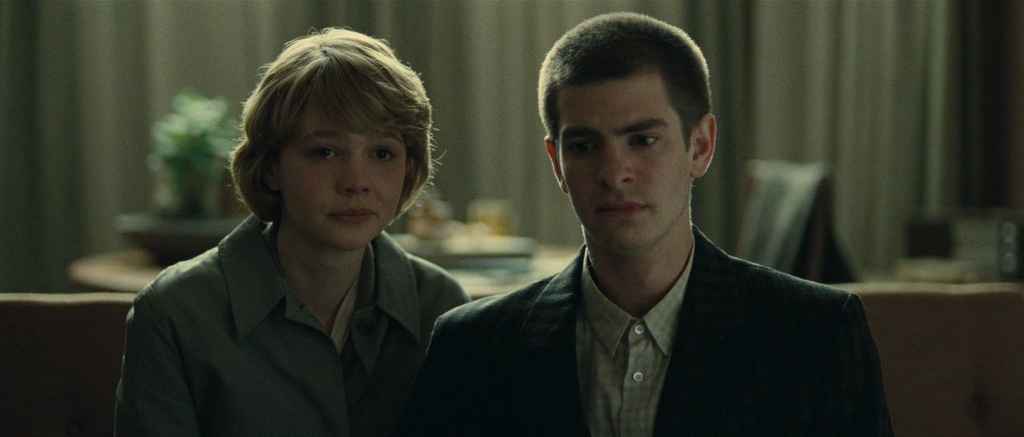
5. J R R Tolkien, The Hobbit
The eponymous hobbit Bilbo is engaged in a game of riddles with the strange creature Gollum.
"What have I got in my pocket?" he said aloud. He was talking to himself, merely Gollum thought it was a riddle, and he was frightfully upset.
"Not fair! not off-white!" he hissed. "It isn't off-white, my precious, is it, to ask u.s. what it's got in its nassty piddling pocketses?"
Bilbo seeing what had happened and having nil better to ask stuck to his question. "What have I got in my pocket?" he said louder. "S-s-s-due south-s," hissed Gollum. "Information technology must give united states three guesseses, my precious, iii guesseses."
"Very well! Guess abroad!" said Bilbo.
"Handses!" said Gollum.
"Incorrect," said Bilbo, who had luckily just taken his hand out again. "Guess once more!"
"S-due south-south-s-southward," said Gollum, more upset than always.
Tolkein's dialogue for Gollum is a masterclass in creating distinct graphic symbol voices. By using a repeated catchphrase ("my precious") and anarchistic spelling and grammer to reflect his unusual speech pattern, Tolkein creates idiosyncratic, unique (and iconic) speech for Gollum. This vivid approach to formatting dialogue, which is almost a transliteration of the sounds Gollum makes, allows readers to imagine his spoken communication pattern and practically hear it aloud.
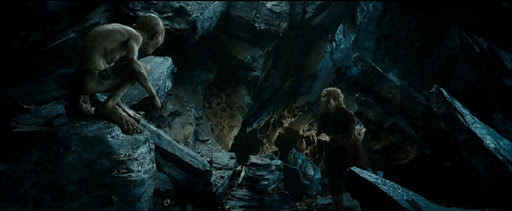
Nosotros wouldn't recommend using this extreme level of idiosyncrasy too oftentimes in your writing — it can get wearing for readers after a while, and Tolkien deploys it sparingly, as Gollum'south appearances are limited to a handful of scenes. However, y'all can use Tolkien's approach equally inspiration to create (slightly more subtle) quirks of speech for your own characters.
6. F Scott Fitzgerald, The Great Gatsby
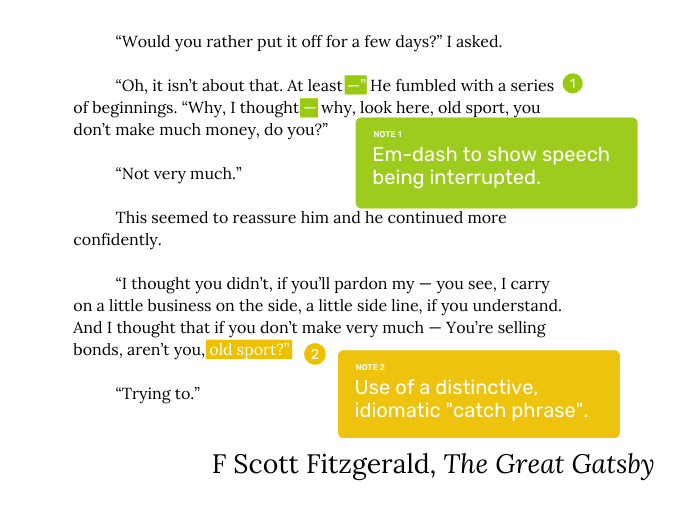
The narrator Nick has just done his new neighbour Gatsby a favor by inviting his beloved Daisy over to tea. Perhaps in render, Gatsby then attempts to brand a shady business suggestion.
"There'due south another picayune affair," he said uncertainly, and hesitated.
"Would you rather put it off for a few days?" I asked.
"Oh, it isn't about that. At least —" He fumbled with a serial of ancestry. "Why, I thought — why, look here, erstwhile sport, y'all don't make much coin, do you?"
"Not very much."
This seemed to reassure him and he continued more than confidently.
"I thought you didn't, if you'll pardon my — you see, I deport on a trivial business organization on the side, a little side line, if you empathise. And I thought that if you don't brand very much — You're selling bonds, aren't you, old sport?"
"Trying to."
This dialogue from The Great Gatsby is a keen example of how to make dialogue sound natural. Gatsby tripping over his own words (fifty-fifty interrupting himself, as marked by the em-dashes) not only makes his nerves and awkwardness palpable, but also mimics real voice communication. Just every bit existent people ofttimes stammer and brand simulated starts when they're speaking off the cuff, Gatsby likewise flounders, giving us insight into his self-doubt; his voice communication isn't polished and perfect, and neither is he despite all his efforts to appear and then.
Fitzgerald also creates a distinctive voice for Gatsby by littering his oral communication with the graphic symbol'south signature term of endearment, "erstwhile sport". We don't even really need dialogue markers to know who'south speaking here — a sign of very strong characterization through dialogue.
7. Arthur Conan Doyle, A Report in Ruddy
In this starting time meeting between the two heroes of Conan Doyle's Sherlock Holmes stories, Sherlock Holmes and John Watson, John is introduced to Sherlock while the latter is hard at work in the lab.
"How are y'all?" he said cordially, gripping my hand with a strength for which I should hardly accept given him credit. "You have been in Afghanistan, I perceive."
"How on world did y'all know that?" I asked in astonishment.
"Never mind," said he, chuckling to himself. "The question now is about hemoglobin. No doubt y'all meet the significance of this discovery of mine?"
"It is interesting, chemically, no incertitude," I answered, "only practically— "
"Why, man, it is the almost practical physician-legal discovery for years. Don't you see that information technology gives us an infallible test for blood stains. Come up over here now!" He seized me past the coat-sleeve in his eagerness, and drew me over to the tabular array at which he had been working. "Let u.s.a. have some fresh blood," he said, digging a long bodkin into his finger, and drawing off the resulting drop of blood in a chemical pipette. "Now, I add this modest quantity of claret to a litre of water. You perceive that the resulting mixture has the appearance of pure h2o. The proportion of claret cannot be more than one in a million. I have no doubt, even so, that we shall be able to obtain the feature reaction." As he spoke, he threw into the vessel a few white crystals, and then added some drops of a transparent fluid. In an instant the contents assumed a dull mahogany colour, and a brownish dust was precipitated to the bottom of the glass jar.
"Ha! ha!" he cried, clapping his easily, and looking equally delighted as a kid with a new toy. "What practise yous recall of that?"
This passage uses a number of the key techniques for writing naturalistic and exciting dialogue, including characters speaking over 1 another, and the interspersal of action beats.
Sherlock cutting off Watson to launch into a monologue nearly his blood experiment shows immediately where Sherlock'southward involvement lies — not in minor talk, or the person he is speaking to, just in his own pursuits, just similar before in the conversation when he refuses to explain anything to John and is instead cocky-absorbedly "chuckling to himself". This helps establish their initial rapport (or lack thereof) very apace.
Breaking up that monologue with snippets of him undertaking the forensic tests allows u.s. to experience the full force of his enthusiasm over it without having to read an uninterrupted speech nigh the ins and outs of a science experiment.
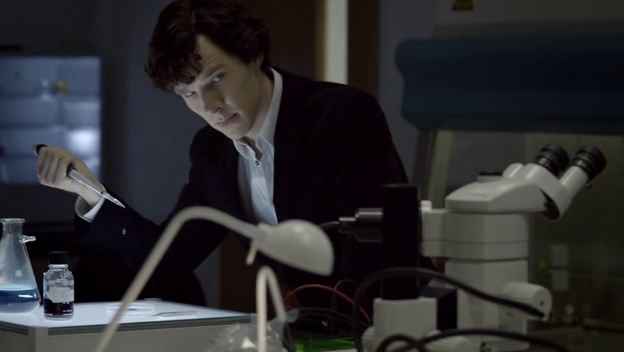
Starting to recall you lot might similar to read some Sherlock? Check out our guide to the Sherlock Holmes catechism !
eight. Brandon Taylor, Real Life
Here, our protagonist Wallace is questioned by Ramon, a friend-of-a-friend, over the fact that he is because leaving his PhD programme.
Wallace hums. "I mean, I wouldn't say that I desire to leave, only I've thought about it, sure."
"Why would y'all practice that? I mean, the prospects for… black people, you lot know?"
"What are the prospects for blackness people?" Wallace asks, though he knows he will be considered the attacker for this question.
Brandon Taylor's Real Life is drawn from the author's ain experiences as a queer Blackness homo, attempting to navigate the unwelcoming world of academia, navigating the globe of academia, and so it's no surprise that his dialogue rings so true to life — it's 1 of the reasons the novel is ane of our picks for must-read books past Black authors.
This episode is role of a blueprint where Wallace is casually cornered and questioned by people who never question for a moment whether they have the right to ambush him or criticise his choices. The utilise of indirect dialogue at the end shows us this is a well-trodden path for Wallace: he has had this same conversation several times, and can pre-empt the exact issue.
This scene is also a great case of the dramatic significance of people choosing not to speak. The exchange happens in forepart of a big group, but — despite their apparent discomfort — nobody speaks upward to defend Wallace, or to criticize Ramon's patronizing microaggressions. Their silence is deafening, and nosotros get a glimpse of Ramon'south isolation due to the complacency of others, all due to what is non said in this dialogue example.
9. Ernest Hemingway, Hills Similar White Elephants
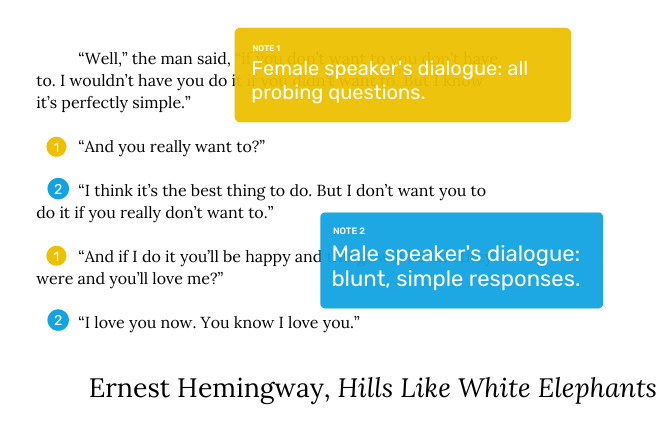
In this short story, an unnamed man and a young woman talk over whether or not they should terminate a pregnancy, while sitting on a railroad train platform.
"Well," the man said, "if y'all don't desire to you don't accept to. I wouldn't have you do it if you didn't want to. Simply I know it's perfectly simple."
"And y'all actually want to?"
"I think it's the all-time thing to do. But I don't desire you to do it if you actually don't want to."
"And if I practise it you'll be happy and things will be like they were and yous'll love me?"
"I beloved you now. You know I dearest you."
"I know. But if I do it, and so it will be nice once again if I say things are similar white elephants, and yous'll similar it?"
"I'll love information technology. I honey it now but I just can't think about it. Yous know how I get when I worry."
"If I practise it yous won't always worry?"
"I won't worry about that considering information technology's perfectly simple."
This example of dialogue from Hemingway'due south short story Hills Similar White Elephants moves at quite a clip. The conversation quickly bounces back and forth between the speakers, and the call-and-response format of the woman request and the man answering is effective because it establishes a clear dynamic between the two speakers: the adult female is the 1 seeking reassurance and trying to sympathise the human's feelings, while he is the 1 who is ultimately in control of the situation.
Note the sparing use of dialogue markers: this minimalist approach keeps the dialogue brisk, and we can still easily sympathise who is who due to the use of a new paragraph when the speaker changes.
Like this classic author's style? Head over to our pick of the 11 best Ernest Hemingway books .
10. Madeline Miller, Circe
In Madeline Miller's retelling of Greek myth, we witness a conversation between the mythical enchantress Circe and Telemachus (son of Odysseus).
"Y'all practice not grieve for your father?"
"I do. I grieve that I never met the father everyone told me I had."
I narrowed my eyes. "Explain.""I am no storyteller."
"I am non asking for a story. Y'all have come to my island. You owe me truth."A moment passed, and then he nodded. "You will take it."
This short and punchy substitution hits on a lot of the stylistic points nosotros've covered so far. The conversation is a taut lawn tennis match between the two speakers, as they volley back and forth with short only impactful sentences, and unnecessary dialogue tags accept been shaved off. It besides highlights Circe'southward imperious attitude, a result of her divine status. Her utilise of curt, snappy declaratives and imperatives demonstrates that she's used to getting her own way, and feels no need to mince her words.
11. Andre Aciman, Call Me By Your Name
This is an early conversation between seventeen year old Elio and his family's handsome new pupil lodger, Oliver.
What did ane do effectually hither? Nothing. Look for summer to end. What did ane practice in the wintertime, and then?
I smiled at the answer I was about to give. He got the gist and said, "Don't tell me: expect for summertime to come, correct?"
I liked having my mind read. He'd pick upwardly on dinner drudgery sooner than those before him.
"Actually, in the winter the identify gets very gray and dark. We come up for Christmas. Otherwise it's a ghost town."
"And what else practise you do hither at Christmas besides roast chestnuts and potable eggnog?"
He was teasing. I offered the same grin every bit before. He understood, said nothing, we laughed.
He asked what I did. I played tennis. Swam. Went out at dark. Jogged. Transcribed music. Read.
He said he jogged likewise. Early on in the morn. Where did one jog around here? Along the promenade, mostly. I could bear witness him if he wanted.
It hit me in the face just when I was starting to like him again: "Later, perhaps."
Dialogue is one of the most crucial aspects of writing romance — what's a literary human relationship without some flirty lines? Here, however, Aciman gives the states a great example of efficient dialogue. By removing unnecessary dialogue and instead summarizing with narration, he's able to confer the gist of the chat without slowing down the pace unnecessarily. Instead, the emphasis is left on what's unsaid, the developing romantic subtext.
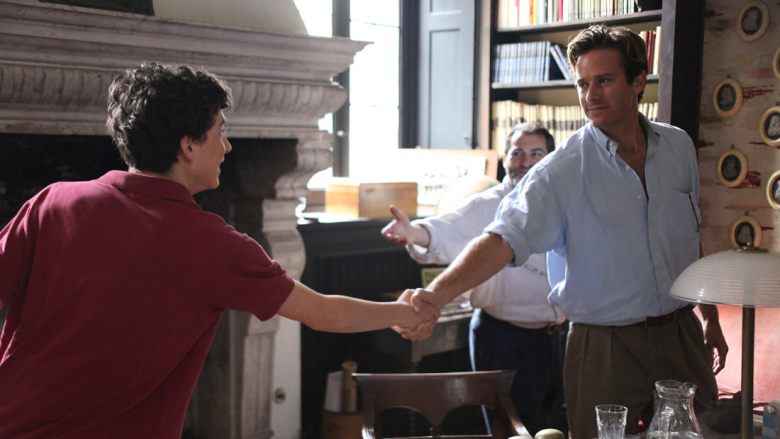
Furthermore, the fact that we receive this scene in half-reported snippets rather than as an uninterrupted transcript emphasizes the fact that this is Elio'due south ain recollection of the story, every bit the manipulation of the dialogue in this way serves to mimic the nostalgic haziness of retention.
12. George Eliot, Middlemarch
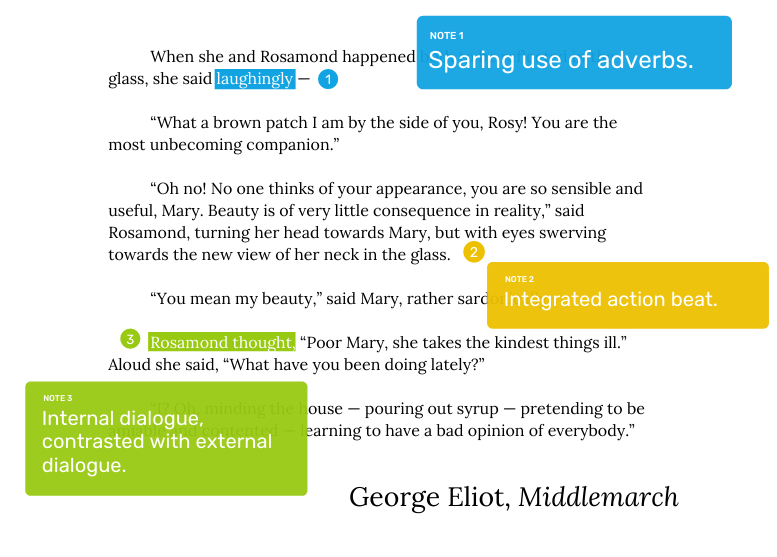
Two of Eliot'southward characters, Mary and Rosamond, are out shopping,
When she and Rosamond happened both to exist reflected in the glass, she said laughingly —
"What a dark-brown patch I am past the side of you, Rosy! You are the most unbecoming companion."
"Oh no! No i thinks of your appearance, you are then sensible and useful, Mary. Beauty is of very lilliputian consequence in reality," said Rosamond, turning her head towards Mary, just with optics swerving towards the new view of her neck in the glass.
"You mean my beauty," said Mary, rather sardonically.
Rosamond thought, "Poor Mary, she takes the kindest things ill." Aloud she said, "What have you been doing lately?"
"I? Oh, minding the house — pouring out syrup — pretending to be amiable and contented — learning to have a bad opinion of everybody."
This excerpt, a conversation betwixt the level-headed Mary and vain Rosamond, is an case of dialogue that develops character relationships naturally. The use of action descriptors allows us to understand what is really happening in the conversation.
Whilst the oral communication alone might lead usa to believe Rosamond is honestly (if clumsily) engaging with her friend, the description of her simultaneously gazing at herself in a mirror gives usa insight not just into her vanity, but too into the fact that she is not really engaged in her conversation with Mary at all.
The use of internal dialogue cutting into the conversation (hither formatted with quotation marks rather than the usual italics) lets us know what Rosamond is really thinking, and the contrast between this and what she says aloud is telling. The fact that we know she privately realizes she has offended Mary, simply quickly continues the conversation rather than apologizing, is emphatic of her character. We go to know Rosamond very well within this short passage, which is a hallmark of effective character-driven dialogue.
thirteen. John Steinbeck, The Winter of our Discontent
Here, Mary (speaking first) reacts to her married man Ethan'due south attempts to discuss his previous experiences as a disciplined soldier, his struggles in subsequent life, and his feeling of impending modify.
"Yous're trying to tell me something."
"Sadly enough, I am. And it sounds in my ears like an apology. I hope it is not."
"I'm going to ready out lunch."
Steinbeck'south Wintertime of our Discontent is an astute written report in alienation and miscommunication, and this substitution exemplifies the ways in which characters tin fail to communicate, even when they're speaking. The pair speaking hither are trapped in a dysfunctional marriage which leaves Ethan feeling isolated, and part of the loneliness he feels comes from the accumulation of exchanges such every bit this one. Whenever he tries to communicate meaningfully with his wife, she shuts the conversation downwards with a consummate not sequitur.
We expect Mary'south "you're trying to tell me something" to be followed past a revelation, but Ethan is non forthcoming in his response, and Mary then exits the conversation entirely. Nothing is communicated, and the jarring and frustrating effect of having our expectations subverted goes a long fashion in mirroring Ethan's ain frustration.
Merely like Ethan and Mary, nosotros receive no emotional pay-off, and this passage of characters talking by one another doesn't further the plot as nosotros hope it might, but instead gives the states insight into the extent of these characters' estrangement.
14. Bret Easton Ellis, Less Than Zero
The disillusioned main graphic symbol of Bret Easton Ellis' debut novel, Clay, here catches up with a higher friend, Daniel, whom he hasn't seen in a while.
He keeps rubbing his oral cavity and when I realize that he's not going to answer me, I inquire him what he's been doing.
"Been doing?"
"Aye."
"Hanging out."
"Hanging out where?"
"Where? Around."
Less Than Goose egg is an elegy to conversation, and this dialogue is an example of the many vacuous exchanges the protagonist engages in, seemingly just to fill time. The whole book is deliberately unpoetic and flat, and depicts the lives of disaffected youths in 1980s LA. Their misguided attempts to fill the emptiness within them with drink and drugs are ultimately fruitless, and it shows in their conversations: in truth, they have null to say to ane other at all.
This utterly meaningless exchange would elsewhere be considered dead weight to a story. Here, rather than being fat in need of trimming, the empty conversation is instead thematically resonant.
fifteen. Daphne du Maurier, Rebecca
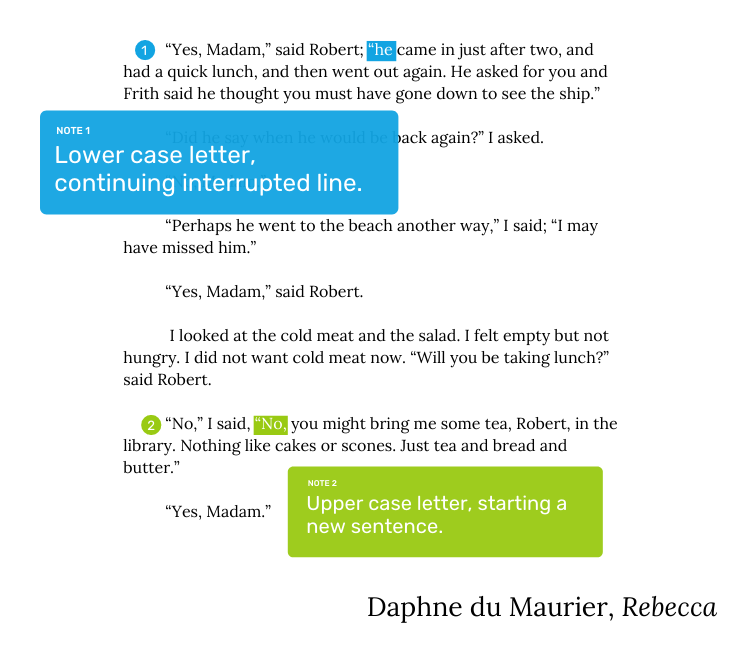
The young narrator of du Maurier's classic gothic novel here has a strained conversation with Robert, one of the young members of staff at her new husband's home, the unwelcoming Manderley.
"Has Mr. de Winter been in?" I said.
"Yes, Madam," said Robert; "he came in but after 2, and had a quick lunch, and so went out once again. He asked for you and Frith said he thought you must accept gone down to run into the ship."
"Did he say when he would be back once again?" I asked.
"No, Madam."
"Perchance he went to the beach another way," I said; "I may take missed him."
"Yes, Madam," said Robert.
I looked at the cold meat and the salad. I felt empty but not hungry. I did not want cold meat at present. "Will you be taking luncheon?" said Robert.
"No," I said, "No, you might bring me some tea, Robert, in the library. Nothing like cakes or scones. Just tea and bread and butter."
"Yes, Madam."
The reason nosotros're including this one in our dialogue examples list is to evidence you the power of everything Du Maurier doesn't do: rather than cycling through a ton of fancy synonyms for "said", she opts for spare dialogue and tags.
The cold, thin tone in this interaction complements the lack of warmth the protagonist is feeling in the moment depicted here. By keeping the dialogue tags elementary, the author ratchets upward the tension — without any distracting flourishes taking the reader out of the scene. The subtext of the conversation is able to simmer nether the surface, and we aren't beaten over the head with whatever phase direction extras.
The inclusion of three sentences of internal dialogue in the center of the dialogue ("I looked at the common cold meat and the salad. I felt empty but not hungry. I did not want cold meat at present.") is as well a masterful touch. What could have been a single sentence is stretched into three, creating a massive pregnant break before Robert continues speaking, without having to explicitly signpost 1. Manipulating the stride of dialogue in this mode and manufacturing meaningful silence is a great fashion of adding depth to a scene.
Phew! Nosotros've been through a lot of dialogue, from first meetings to idle chit chat to confrontations, and nosotros promise these dialogue examples take been helpful in illustrating some of the about mutual techniques.
If you're looking for more pointers on how to create conceivable and constructive dialogue, exist sure to check out our course on writing dialogue. Or, if you discover yous larn better through examples, you can have a expect at our list of 100 books to read before you dice — information technology'due south packed full of skillful storytellers who've really honed the art of dialogue.
mcdonaldhationge41.blogspot.com
Source: https://blog.reedsy.com/guide/how-to-write-dialogue/dialogue-examples/


0 Response to "Dialogue Examples for a Person Seeing There Father Again"
Post a Comment